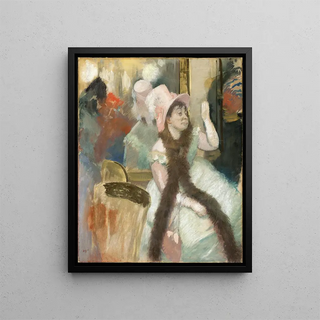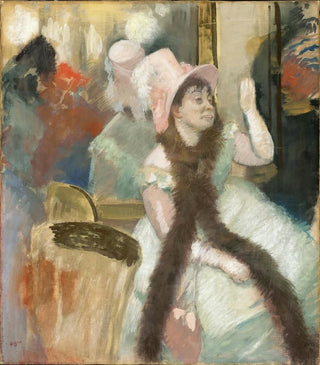Painting Portrait d'après un bal costumé Portrait de Madame Dietz-Monnin - Edgar Degas | Art print


View from behind

Frame (optional)
Edgar Degas' "Portrait after a masked ball Portrait of Madame Dietz-Monnin" is a work that transcends the simple frame of painting to offer a captivating immersion into the 19th-century universe. This painting, both intimate and theatrical, captures the essence of an era where social life and the arts intertwined with rare elegance. Degas, renowned for his ability to seize movement and emotion, manages here to immortalize a female figure with such depth that she almost seems to come to life before our eyes. The depiction of Madame Dietz-Monnin, dressed in a richly adorned costume, evokes not only the charm of masked balls but also the complexity of human relationships and social conventions of her time.
Style and uniqueness of the work
In this piece, Degas employs a subtle palette and controlled brushstrokes to create an atmosphere that is both festive and melancholic. Light plays a crucial role, illuminating Madame Dietz-Monnin's face while allowing the details of her costume to blend into an artistic blur. This stylistic choice reinforces the idea of ephemeral reality, as if the captured moment is about to fade away. The textures of the fabrics and the nuances of color testify to Degas' skill in rendering the richness of materials, while the slightly nonchalant pose of the model suggests a personality that is both strong and enigmatic. This painting stands out for its ability to combine realism and impressionism, making each brushstroke an invitation to explore the emotions hidden behind Madame Dietz-Monnin's smile.
The artist and his influence
Edgar Degas, an emblematic figure of the Impressionist movement, distinguished himself with his unique vision of urban life and ballet scenes. His work, although often associated with representations of dancers, extends to portraits and scenes of everyday life that reveal a particular sensitivity to the psychology of his subjects. Degas' ability to observe and capture human essence has influenced many artists, both contemporaries and successors. His innovative approach to composition and

Matte finish

View from behind

Frame (optional)
Edgar Degas' "Portrait after a masked ball Portrait of Madame Dietz-Monnin" is a work that transcends the simple frame of painting to offer a captivating immersion into the 19th-century universe. This painting, both intimate and theatrical, captures the essence of an era where social life and the arts intertwined with rare elegance. Degas, renowned for his ability to seize movement and emotion, manages here to immortalize a female figure with such depth that she almost seems to come to life before our eyes. The depiction of Madame Dietz-Monnin, dressed in a richly adorned costume, evokes not only the charm of masked balls but also the complexity of human relationships and social conventions of her time.
Style and uniqueness of the work
In this piece, Degas employs a subtle palette and controlled brushstrokes to create an atmosphere that is both festive and melancholic. Light plays a crucial role, illuminating Madame Dietz-Monnin's face while allowing the details of her costume to blend into an artistic blur. This stylistic choice reinforces the idea of ephemeral reality, as if the captured moment is about to fade away. The textures of the fabrics and the nuances of color testify to Degas' skill in rendering the richness of materials, while the slightly nonchalant pose of the model suggests a personality that is both strong and enigmatic. This painting stands out for its ability to combine realism and impressionism, making each brushstroke an invitation to explore the emotions hidden behind Madame Dietz-Monnin's smile.
The artist and his influence
Edgar Degas, an emblematic figure of the Impressionist movement, distinguished himself with his unique vision of urban life and ballet scenes. His work, although often associated with representations of dancers, extends to portraits and scenes of everyday life that reveal a particular sensitivity to the psychology of his subjects. Degas' ability to observe and capture human essence has influenced many artists, both contemporaries and successors. His innovative approach to composition and
12,34 €






